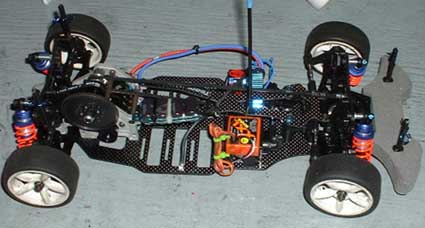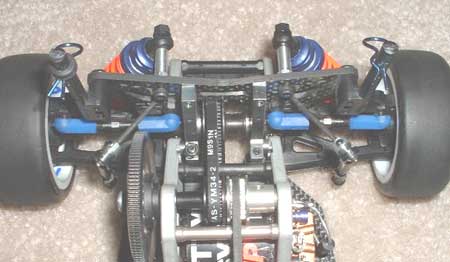|
Atlas YM-34 Review
I had seen
the Atlas car in one of Car Action's touring car
special issues. It looked totally awesome! Anyway,
I had thought about buying one, but the cost seemed
prohibitive. In November, Integy, the importer,
dropped the car's price almost $50, and I was
sold.
 This
is how the car comes out of the box, minus electronics.
Note graphite parts, threaded shocks, metal bulkhead/motor
mount. Pretty good for a $200 kit. This
is how the car comes out of the box, minus electronics.
Note graphite parts, threaded shocks, metal bulkhead/motor
mount. Pretty good for a $200 kit.
Build
Up
When the car arrived,
I put it together in about 7-8 hours. The parts
quality was excellent, which reassured me since
the car was an unknown to me. In fact, the only
flaw that really stuck out was the fact that the
countersinking was not that great. Some of the plastic
was a little more flexible than I would have liked,
but they do offer graphite versions of most of the
parts.
The metal parts were flawless, however. Having the
motor mount and side plate included in the kit was
excellent considering the price, especially since
threaded shocks and all the woven graphite are also
included too.Another nice part was that the car
was not overly sloppy. While there was some tolerance,
it wasn't as bad as some cars that I have put together.
Not a pivot ball car, but good.
Assembly was ok despite the horrendous translation
from Japanese, ("foolishness prevention"?). What
saved the manual had to be the excellent drawings
and parts diagrams. I didn't have much trouble figuring
what was what. Someone not familiar with r/c would
definitely have a hard time, though.
The diffs are of the Associated/HPI style. Once
assembled, they were pretty smooth. I do recommend
getting some HPI 2.4 mm diff nuts, as there is a
part on the tree which uses those nuts instead of
just threading the screw into a plastic nut. Delrin
halves are also available for even more drive train
lightening. The car accelerates well with steel
halves, so I can't imagine how rocket like it would
be with the plastic halves.
As I mentioned before, I countersunk the chassis,
and also beveled the battery slots. For 2400s and
3000s you may need to lengthen the slots as well.
Tape is the recommended battery securing system,
and while the tape slots are wide and easy to deal
with, Schumacher battery hold downs are rumored
to fit nicely on the chassis. Tape is sort of lame,
so I intend on trying the Schumacher stuff.
Once the chassis is together, the flex probably
less than a Pro2, but there is still flex evident.
The metal bulkhead cuts down on the flexing. I always
felt that the HPI, or any 2 deck car needed a metal
bulkhead, and this car is that much ahead of the
game. What is also nice is that the bulkheads are
not part of the suspension mounts, so there is quite
a bit of adjustability that I'll get into later.
Another really great feature of the kit is that
threaded shocks are stock. The shocks also can be
built with a bladder, and filled from the top, or
filled from the bottom Losi style. I have found
so far that the Losi style bottom fill is the easiest
to get the shocks consistent. Otherwise they are
very smooth, and the threaded collars adjust easily.

The shock towers are also interesting in that they
are slightly thicker than the chassis plate. This
helps to cut down on flex. The only problem is that
the kit plastic is flexible, and the diff housings,
which the towers bolt to, allow the towers to move
too much to be effective. Both graphite plastic
and aluminum diff housings are available. Still,
a better quality plastic would help quite a bit.
The rest of the parts are excellent quality. Steel
turnbuckles, steel CVD type drive shafts, rubber
sealed ball bearings, they all add up to great value.
Like I said the only gripe is the plastic composition.
The amount of adjustment on this car really sets
it apart from the rest of the cars that it is often
mistaken for. "It looks like an HPI". HPIs don't
allow you to change the rear roll center and kick
up out of the box, nor do they have more than 2
choices for the inboard camber link position. The
front also has the same features. Really, the car
it is more comparable to would be an Xpress. This
is a racecar more than a beginner's car.

Performance
Once built, I took off
for S&N's Trackside Raceway in Milwaukee, WI. I
had set the car up to the spec's from the setup
sheet from Integy's website. The only changes I
made from their setup was to run 10wt lighter oil
in the rear, 7* of caster in the front, and to make
the rear camber link as long as possible.
As soon as I threw the car on the track, it felt
great. I was surprised at how quick it was as well.
The car had very good acceleration out of the corner.
I ran in the pro stock class for the night.
After the two qualifiers, I was 5th in the A. Not
bad, but the car didn't turn in as hard as I would
have liked. In retrospect, 9* of caster would have
been better. After having had the car for a little
while now, I see it needs more caster to turn in
from high speed.
In the main, I had a very good run. I came from
the back of the field to the fight for 2nd, 3rd,
and 4th. After a few laps, I had the 2nd place car
in my sights. I definitely was faster than him,
but a "racing incident" put me back to 6th. With
only about 45 seconds left, the only thing I could
do was to catch the 5th place car and pass him.
The other cars were too far gone.
I again raced the car at S&N's on New Years' Day.
This time the race was not as successful. I managed
to dial myself out early in the day. Basically,
I lowered the front roll center too much, resulting
in the car looking like a big Caddy out on the track.
I tried to use stiffer springs and oil, but the
car was only marginally better. As I found out later,
the difference of the roll center's height from
the center of gravity's height caused the car to
sway like a pendulum. My results that day weren't
too good, although I did manage to come from last
starting position in my stock race to 2nd.
My latest testing seems to show the rear suspension
mounts should be 2 to 4mm high, and the front 1.5
to 2.5mm. The front should generally be lower than
the rear. That way the rear roll center is higher
than the front roll center. I also run a minimum
of 1mm kick up in the rear, and 0 to 1mm in the
front. Your mileage may vary, however. This seems
to be what works for carpet. I also recommend sway
bars for the car.
Overall, I felt the car was excellent the first
time I ever raced it. It was one of the faster cars
on the track! With a little more dialing in time,
I think it will be able to run with and from any
of the top cars out there.
|